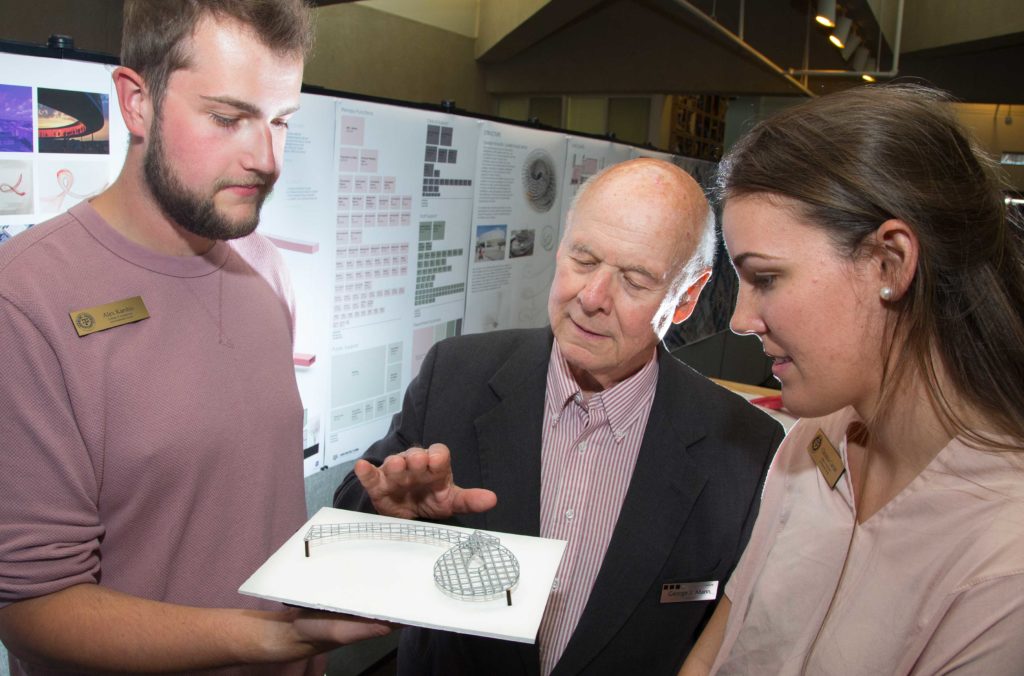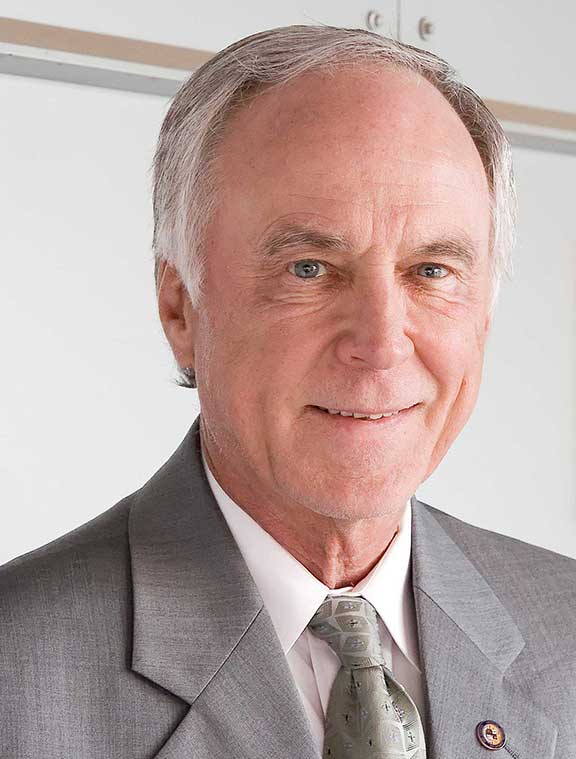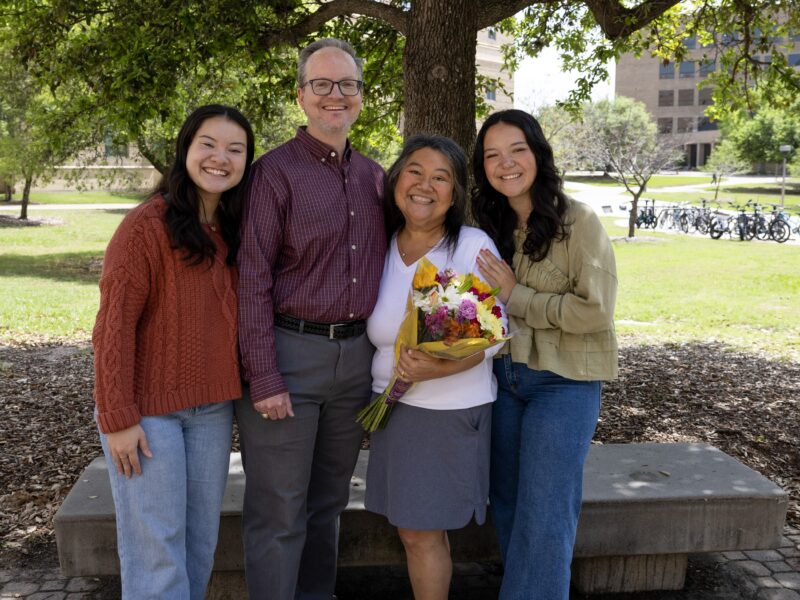George J. Mann doesn’t like the word “hospital.”
“Hospital,” he said, “conjures up images of a ‘house of sickness.’ But ‘health’ has a more positive connotation.” So while designing hospitals is a critical function of Mann’s role as a Texas A&M University architecture professor, the groundbreaking architecture for health specialization he created when he arrived at Texas A&M in 1966 is largely focused on wellness rather than sickness.
Mann underscores this mindset when working alongside students in his health facilities studio design lab. It also guided him as he helped establish Texas A&M’s Center for Health Systems and Design in 1983—a joint venture between the College of Architecture and the College of Medicine.
To honor the man who’s in his 51st year of teaching this architectural specialization—and to support the center that encourages an interdisciplinary approach toward health facilities design—two prominent Aggie architects, Ronald Skaggs ’65 and Joseph Sprague ’70, recently pledged lead gifts to the Texas A&M Foundation to create a faculty chair in Mann’s honor.
Contingent on the generosity of former students and other friends of Mann and the health systems center, an endowment for the George J. Mann Chair in Healthcare Design is slated to be fully funded by 2021, providing a constant stream of support both for the center and its director.
Texas A&M Faculty Chair Endowed For ‘Mann’ With A Plan In Health Care Architecture
A Fire From Within
Mann earned his undergraduate architecture degree from Columbia University in 1961. At the time, the fledgling Peace Corps was in the news, igniting a consciousness among young people of global suffering and a determination to do something about it. Faced with a project decision for his final study and moved by a wave of international awareness, Mann took the unusual measure of writing to 20 health ministries in developing countries, asking if he could design a hospital for them for free. India said “yes.”
Years later, Mann said that his decision to use his architecture skills to make a difference in the world was more of a need than a choice. “I didn’t will it. It just happened,” he said. “It was a fire from within. I knew I had to do something to help people.”
His own background likewise contributed to his yearning to alleviate suffering: His Jewish Austrian family fled the Nazis when he was a baby, and he barely survived his first year in China, where the family sought refuge. “I always felt very lucky to be alive, but I didn’t understand at the time that designing health facilities for those in need was my way of demonstrating my thanks,” he said.
In designing the Indian hospital, Mann managed to impress his Columbia professor, Edward J. Romieniec. In 1966, Romieniec, who served at the time as head of Texas A&M’s Division of Architecture (now Department of Architecture), recruited Mann to create the school’s architecture for health specialization. Half a century later, Aggie architects all over the world credit Mann with igniting a passion within them to use their skills to better the lives of others. Many have gone on to design some of the world’s foremost health facilities, while others have quietly met the needs of more vulnerable clients through thoughtful, functional design.
“We have to be careful that we’re not architects out to impress each other with our designs,” Mann explained, “but are instead doing something that is relevant.”
An Interdisciplinary Approach
Successful health facilities projects can’t be designed in a vacuum. Medical experts, in particular, must be part of the process. It was this understanding that spurred the creation of Texas A&M’s health systems center. Today, the center boasts the world’s largest collection of interdisciplinary faculty, students and affiliated professionals. Its 37 faculty fellows come from every department within the College of Architecture, as well as from several Texas A&M Health Science Center colleges and from the departments of educational psychology, marketing and agriculture.
The center goes beyond architectural renderings to promoting research, innovation and communication related to the health care field. Central to its activities are a weekly visiting lecture series and a Certificate in Health Systems and Design program, open to graduate students in any field.
Financial support for the center comes from the Health Industry Advisory Council (HIAC). For annual individual dues of $5,000, HIAC members give input on health care design education, initiate studio design projects, develop university-industry partnerships and mentor students.
Two of the foremost supporters of the health systems center are Ronald Skaggs ’65, chairman emeritus of international architecture firm HKS Inc., and Joseph Sprague ’70, senior vice president of health facilities at HKS. Skaggs’ relationship with Mann spans the professor’s entire 51 years at Texas A&M. Seeking advice for a graduate study specialization, Mann convinced Skaggs to give health facilities design a try. That conversation not only landed Skaggs in Mann’s first Texas A&M class, but also established the trajectory for Skaggs’ career. “It was the best thing that ever happened to me,” Skaggs said.
Skaggs and Sprague later met while serving in the Army Medical Services Corps. Sprague had earned his architecture degree from Auburn University, but Skaggs convinced him to visit with Mann about graduate school. That conversation (and, Mann claims, the campus golf course) convinced Sprague to join Mann’s fourth graduate school class.
“He became my mentor, and that’s remained the case for a very long time,” Sprague said. Skaggs and Sprague joined forces with another Aggie at HKS, Craig Beale ’71, to create a trifecta of support for health facilities design faculty in the form of two professorships and a chair ten years ago. Mann is the current holder of the Ronald L. Skaggs Endowed Professorship in Health Facilities Design.
Skaggs said that the latest chair is a continuation of this earlier support. This time, though, Mann’s name will be permanently associated with health facilities design at Texas A&M.
While Sprague and Skaggs gave the lead gifts for the Mann chair, its ultimate establishment relies on gifts from others. Once private donors contribute a combined $500,000 to the endowment, the university will contribute matching funds to reach the $1 million required to establish a faculty chair.
“Ron and I have already recognized the wonderful contribution that George has made in our lives,” Sprague said. “This is an opportunity to have more of his students express their thanks for his influence as well.”
Kirk Hamilton, the Julie and Craig Beale ’71 Endowed Professor in Health Facilities Design, first initiated the idea to establish a chair honoring Mann. Before Ray Pentecost assumed directorship of the health systems center last year, Hamilton filled the role on an interim basis. As center leader, he became acutely aware of the center’s financial dependence on HIAC members. Like many industries, architecture experiences its highs and lows. In the low periods, HIAC membership drops, meaning funds to pay for basic functions such as certificate program expenses, faculty fellow salaries and operating costs also decline.
The establishment of a chair for the center director would not only honor Mann’s decades of dedicated teaching and health facilities expertise, Hamilton said, but would also provide a permanent source of income for the center itself.
An Enduring Legacy
While in his studio design lab, Mann’s students have completed more than 800 projects for real clients, ranging from additions to the massive University of Texas M.D. Anderson Cancer Center in Houston to the more modest Twin City Mission Homeless Shelter in Bryan. He’s worked with students to design facilities in countries such as China, Israel and Nigeria as well as mobile endeavors such as the Orbis International Flying Eye Hospital (housed in a DC-10 jet airliner) and Mercy Ships floating hospitals.
Aggie architects all over the world credit George Mann with igniting a passion within them to use their skills to better the lives of others. Many of his former students have designed some of the world’s foremost health care facilities.
Hamilton remarked that this real-world experience is but one way that Mann gives his students an advantage when they enter the health facilities design field.
But Sprague added that Mann’s contributions aren’t only to his students: The world-class reputation of Texas A&M as a leader in health facilities design is, by and large, a product of Mann’s passion and dedication. This new chair will ensure that Texas A&M can always recruit a high-quality director for its health systems center.
“The influence that Professor Mann has had on thousands of students in his 50 years at Texas A&M has really put the university on the map in health facilities design,” Sprague said. “Funding this chair will ensure that his legacy will continue.”
This story was published originally by the Texas A&M Foundation.
###
Media contact: Dunae Crenwelge, marketing and communications specialist for the Texas A&M Foundation, at 979-845-7462 or dunaejc11@tamu.edu; or Elena Watts, Division of Marketing & Communications, at 979-458-8412 or elenaw@tamu.edu.








